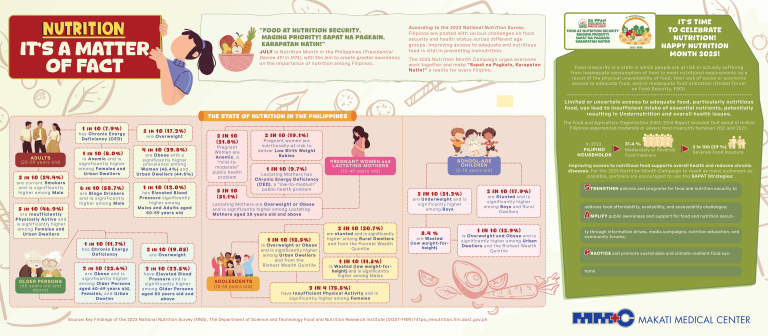It can happen anytime, anywhere—in the middle of a crucial presentation, at the start of a nerve-wracking job interview, or while you’re banging out a report whose deadline was yesterday. And when it strikes, a migraine—that pulsating, debilitating, mother of all headaches—can be so severe it can affect your performance on the job and sideline you from work anywhere for a few hours to several days.
“It’s one of the most common primary forms of headaches, plus, it’s the most disabling,” says Rosalina Espiritu-Picar, MD of the Department of Neurosciences of Makati Medical Center (MakatiMed).
As a migraine sufferer herself, the health practitioner literally knows the pains her patients go through. “Unfortunately, it’s more common among women,” shares Dr. Espiritu-Picar, later pointing out that some of the common triggers include menstruation and menopause. “It also has its peak incidence during your most economically productive years of life, and that’s from your early 20s to your middle-aged years. So, when you do have migraines, you will have problems in terms of how you function at work.”
Genetics, stress, hormonal changes, certain medications, depression, obesity, sleep apnea, poor sleeping habits, and taking too much caffeine, alcohol, and even chocolate are other recognized risk factors for developing chronic migraines.
Is it migraine?
There are headaches—and then there are migraines, a neurological brain disorder that comes in two forms. The common type of migraine is a migraine without aura or a migraine without a warning sign. To know if you have it, see if it answers this mnemonic: 5 4 3 2 1 PUMA.
“You have to have five (5) previous attacks that are similar, they last for four (4) hours and gradually build to up to three (3) days or 72 hours,” explains Dr. Espiritu-Picar. “You also must have at least two (2) of the following manifestations: Pulsating or throbbing pain; Unilateral or one-sided pain; a headache that is Moderate or severe in intensity; and it is Aggravated by activities. You can also have one (1) of the following: Nausea and/or vomiting, and sensitivity to sound and light.”
On the other hand, a migraine with aura is a migraine that occurs after specific triggers. “Sometimes you can have symptoms before the headache itself. That’s what we call a prodrome,” says Dr. Espiritu-Picar.
Prodromes run the gamut of symptoms: food cravings, mood swings, fatigue, stiffness in the neck, constipation, diarrhea, a need to pee, tingling, and a wide range of visual aura like blurry vision, flashes of bright lights, and the like. Some prodromes—vertigo, hallucinations, numbness, difficulty speaking—even mimic symptoms of a stroke.
As migraines can be sheer torture (Dr. Espiritu-Picar in fact has patients who experience such intense pain, they resort to pulling their hair and banging their head against a wall), managing their occurrence is essential, especially if it’s getting in the way of your work. Here are some things you can do:
Keep a diary
To know exactly what sets off your migraines, document when they happen and the circumstances leading up to them. “When you keep your diary long enough, you’ll see a detectable pattern,” shares Dr. Espiritu-Picar.
Perhaps eating food laden with MSG or not getting enough sleep precedes your migraine. “You’ll eventually see common triggers,” she mentions.
Prefer to use your phone instead of paper? The doctor says some do use a free mobile app like Migraine Buddy to help track migraines.
Reduce workplace stressors
Top brass can expect more productivity (and less sick leaves) from migraine sufferers with a few tweaks in the office. Consider flexible working hours and working from home, notes Dr. Espiritu-Picar. Switch to ergonomic desks and chairs to avoid neck strain and anti-glare screens to lessen eye strain. Cultivate your own de-stressing activity too.
And if possible, find a place in the office where you can sit quietly and compose yourself before getting back to work.
Live healthily
Load up on nutritious fruits and vegetables, exercise moderately for most times of the week, keep hydrated, and limit screen time so you can get the recommended eight (8) to nine (9) hours of sleep.
Take medication
A common misconception among Dr. Espiritu-Picar’s patients is that taking migraine medication may lead to drug dependence. “They’d rather suffer through the pain than get used to the medicine,” she says. “This is what you should remember: In terms of pain, the earlier and more efficiently you treat it, the less pain you will produce. This reduces the chance of it getting worse to the point that you need to go to the emergency room because the pain is intolerable.”
Migraine medication can either be specific or non-specific. The latter are NSAIDS—non-steroidal anti-inflammatory drugs that address the inflammatory chemicals released once a migraine starts. Think ibuprofen, paracetamol, and mefenamic acid.
The former include tryptans, which are known to treat migraines with and without aura. There’s also CGRP inhibitors, monthly injectables that block calcitonin gene-related peptide—or CGRP for short. It’s a protein that, when released, produces unbearable migraine pain.
Which is the most effective? That which reduces the frequency of your migraine attacks by at least 50 percent in three (3) months, says Dr. Espiritu-Picar.
“Any therapeutic process begins with an open relationship with a qualified professional and the patient,” she reiterates. “That means I need to know you. I need to understand what other problems you may have so that I can choose the appropriate treatment and medication for you.”
Article based on the Ask Your Neuro interview with Rosalina Espiritu-Picar, MD last October 1, 2021.
For the complete list of Makati Medical Center’s Neurologists, click here. You may also reach us via MakatiMed On-Call at (+632) 8888 8999 or at [email protected].
Follow our social media pages for more health-related content and for the latest updates: https://www.makatimed.net.ph/social-media-pages/











